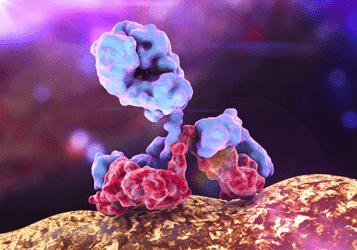- Home
- Products
- Customized ADCs
- Pseudomonas Aeruginosa Serotype IATS O11
- Anti-Pseudomonas aeruginosa serotype IATS O11 (Panobacumab)-SMCC-DM1 ADC
Anti-Pseudomonas aeruginosa serotype IATS O11 (Panobacumab)-SMCC-DM1 ADC (CAT#: ADC-W-2030)
This ADC product is comprised of an anti-Pseudomonas aeruginosa serotype IATS O11 monoclonal antibody conjugated via a SMCC linker to DM1. The DM1 is targeted to certain cancers by immunerecognition and delivered into cancer cells via receptor mediated endocytosis. Within the cell, DM1 binds to tubulins, interrupts microtubule dynamics, and subsequently, induces cell death.
- ADC Target
- ADC Antibody
- ADC Linker
- ADC payload drug
- Name
- Pseudomonas aeruginosa serotype IATS O11
- Alternative Names
- Pseudomonas aeruginosa serotype IATS O11
- Overview
- P. aeruginosa is Gram-negative, aerobic, rod-shaped bacteria with unipolar motility. An opportunistic human pathogen, P. aeruginosa is also an opportunistic pathogen of plants. P. aeruginosa bacteria are clinically important because they are resistant to most antibiotics and they are capable of surviving in conditions that few other organisms can tolerate. Pseudomonas is often encountered in hospital and clinical work because it is a major cause of hospital acquired (nosocomal) infections. Its main targets are immunocompromised individuals, burn victims, and individuals on respirators or with indwelling catheters. Additionally, these pathogens colonize the lungs of cystic fibrosis patients. P. aeruginosa is often identified by its pearlescent appearance and grape-like odor in vitro. Definitive clinical identification of P. aeruginosa includes identifying the production of both pyocyanin and fluorescein as well as its ability to grow at 42°C. P. aeruginosa is capable of growth in diesel and jet fuel, where it is known as hydrocarbon utilizing microorganisms (or "HUM bugs"), causing microbial corrosion. It creates dark gellish mats sometimes improperly called "algae".
- Overview
- Human Anti-Pseudomonas aeruginosa serotype IATS O11 IgM-kappa antibody, Panobacumab
- Generic name
- Panobacumab
- Host animal
- Human
- Name
- SMCC (N-succinimidyl 4-(Nmaleimidomethyl)cyclohexane-1-carboxylate)
- Description
- Disulfide Linkers, are extensively exploited as a chemically labile linkage. Since the release of disulfide-linked drugs requires a cytoplasmic thiol cofactor, such as glutathione (GSH). Disulfides maintain stable at physiological pH and only when ADCs are internalized inside cells, the cytosol provides reducing environment including intracellular enzyme protein disulfide isomerase, or similar enzymes, drugs can be released.
- Name
- DM1 (N2'-Deacetyl-N2'-(3-mercapto-1-oxopropyl)maytansine)
- Description
- Derived from Maytansinoid,a group of cytotoxins structurally similar to rifamycin, geldanamycin, and ansatrienin. The eponymous natural cytotoxic agent maytansine is a 19-member lactam (ansa macrolide) structure originally isolated from the Ethiopian shrub Maytenus ovatus. Maytansinoids can bind to tubulin at or near the vinblastine-binding site, which interfere the formation of microtubules and depolymerize already formed microtubules, inducing mitotic arrest in the intoxicated cells.
For Research Use Only. NOT FOR CLINICAL USE.
Related Products
- Anti-MUC1 (Pemtumomab)-SPDB-DM4 ADC (CAT#: ADC-W-2427)
- Anti-APP (Ponezumab)-SPDB-DM4 ADC (CAT#: ADC-W-711)
- Anti-ERBB2 (Trastuzumab)-DOX ADC (CAT#: ADC-W-571)
- Anti-CD80 (Galiximab)-MC-Vc-PAB-MMAE ADC (CAT#: ADC-W-959)
- Anti-EGFL7 (Parsatuzumab)-MC-Vc-PAB-SN38 ADC (CAT#: ADC-W-1032)
- Anti-MS4A1 (Afutuzumab)-MC-Vc-PAB-MMAE ADC (CAT#: ADC-W-1571)
- Anti-ERBB2 (Trastuzumab)-Gly5-modified DM1 ADC (CAT#: ADC-W-116)
- Anti-IFNG (Crenezumab)-SMCC-DM1 ADC (CAT#: ADC-W-1226)
- Anti-CD40 (Lucatumumab)-SMCC-DM1 ADC (CAT#: ADC-W-908)
- Anti-CFD (Lampalizumab)-MC-MMAF ADC (CAT#: ADC-W-982)
Published Data
+ Submit Publications

Scientific Resources
Customer Reviews and FAQs
There are currently no Customer reviews or questions for ADC-W-2030. Click the button above to contact us or submit your feedback about this product.
Quick Links
Other Products
Same Target
Same Linker
Same Payload
| CAT# | Product Name | Linker | Payload |
| ADC-W-2031 | Anti-Pseudomonas aeruginosa serotype IATS O11 (Panobacumab)-SPDB-DM4 ADC | SPDB (N-succinimidyl-4-(2-pyridyldithio)butyrate) | DM4 (N2'-Deacetyl-N2'-(4-mercapto-4-methyl-1-oxopentyl)maytansine) |
| ADC-W-2032 | Anti-Pseudomonas aeruginosa serotype IATS O11 (Panobacumab)-MC-MMAF ADC | MC (maleimidocaproyl) | MMAF |
| ADC-W-2033 | Anti-Pseudomonas aeruginosa serotype IATS O11 (Panobacumab)-MC-Vc-PAB-MMAE ADC | MC-Vc-PAB (maleimidocaproyl-valine-citrulline-p-aminobenzoyloxycarbonyl) | MMAE |
| ADC-W-2035 | Anti-Pseudomonas aeruginosa serotype IATS O11 (Panobacumab)-MC-Vc-PAB-DMEA-(PEG2)-duocarmycin SA ADC | MC-Vc-PAB-DMEA-(PEG2) | duocarmycin SA |
| ADC-W-2034 | Anti-Pseudomonas aeruginosa serotype IATS O11 (Panobacumab)-MC-Vc-PAB-SN38 ADC | MC-Vc-PAB (maleimidocaproyl-valine-citrulline-p-aminobenzoyloxycarbonyl) | SN-38 (7-ethyl-10-hydroxycamptothecin) |
| CAT# | Product Name | Linker | Payload |
| ADC-W-495 | Anti-EGFR-SMCC-DM1 ADC-4 | SMCC (N-succinimidyl 4-(Nmaleimidomethyl)cyclohexane-1-carboxylate) | DM1 (N2’-Deacetyl-N2’-(3-mercapto-1-oxopropyl)maytansine) |
| ADC-W-582 | Anti-ERBB2-SMCC-DM1 ADC | SMCC (N-succinimidyl 4-(Nmaleimidomethyl)cyclohexane-1-carboxylate) | DM1 (N2’-Deacetyl-N2’-(3-mercapto-1-oxopropyl)maytansine) |
| ADC-W-496 | Anti-EGFR-SMCC-DM1 ADC | SMCC (N-succinimidyl 4-(Nmaleimidomethyl)cyclohexane-1-carboxylate) | DM1 (N2’-Deacetyl-N2’-(3-mercapto-1-oxopropyl)maytansine) |
| ADC-W-2604 | Anti-ITGB3 (Tadocizumab)-SMCC-DM1 ADC | SMCC (N-succinimidyl 4-(Nmaleimidomethyl)cyclohexane-1-carboxylate) | DM1 (N2'-Deacetyl-N2'-(3-mercapto-1-oxopropyl)maytansine) |
| ADC-W-504 | Anti-EGFR (cetuximab)-SMCC-Doxorubicin ADC | SMCC (N-succinimidyl 4-(Nmaleimidomethyl)cyclohexane-1-carboxylate) | Doxorubicin |
| CAT# | Product Name | Linker | Payload |
| ADC-W-2598 | Anti-GPNMB (Glembatumumab)-SMCC-DM1 ADC | SMCC (N-succinimidyl 4-(Nmaleimidomethyl)cyclohexane-1-carboxylate) | DM1 (N2'-Deacetyl-N2'-(3-mercapto-1-oxopropyl)maytansine) |
| ADC-W-2554 | Anti-CD79B (Polatuzumab )-SMCC-DM1 ADC | SMCC (N-succinimidyl 4-(Nmaleimidomethyl)cyclohexane-1-carboxylate) | DM1 (N2'-Deacetyl-N2'-(3-mercapto-1-oxopropyl)maytansine) |
| ADC-W-2532 | Anti-CD22 (Pinatuzumab)-SMCC-DM1 ADC | SMCC (N-succinimidyl 4-(Nmaleimidomethyl)cyclohexane-1-carboxylate) | DM1 (N2'-Deacetyl-N2'-(3-mercapto-1-oxopropyl)maytansine) |
| ADC-W-2571 | Anti-SLC34A2 (Lifastuzumab )-SMCC-DM1 ADC | SMCC (N-succinimidyl 4-(Nmaleimidomethyl)cyclohexane-1-carboxylate) | DM1 (N2'-Deacetyl-N2'-(3-mercapto-1-oxopropyl)maytansine) |
| ADC-W-2620 | Anti-NCAM1 (Lorvotuzumab )-SMCC-DM1 ADC | SMCC (N-succinimidyl 4-(Nmaleimidomethyl)cyclohexane-1-carboxylate) | DM1 (N2'-Deacetyl-N2'-(3-mercapto-1-oxopropyl)maytansine) |
Online Inquiry
Welcome! For price inquiries, please feel free to contact us through the form on the left side. We will get back to you as soon as possible.



